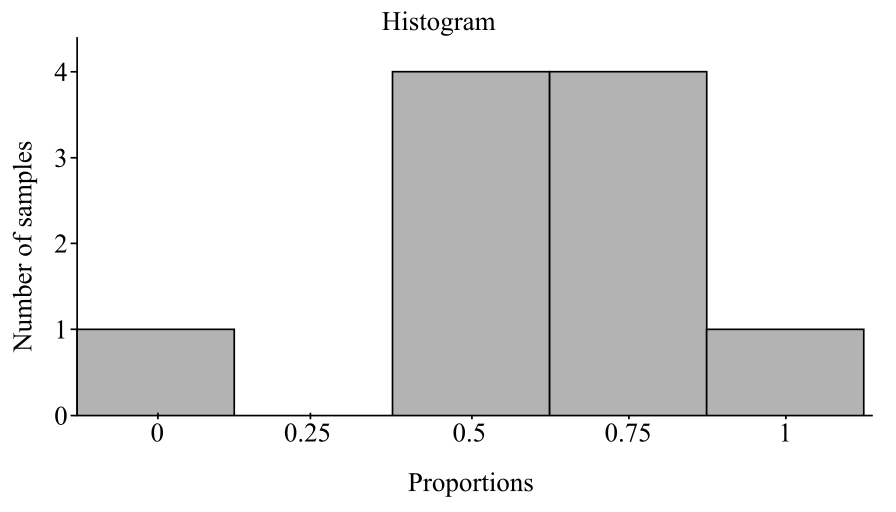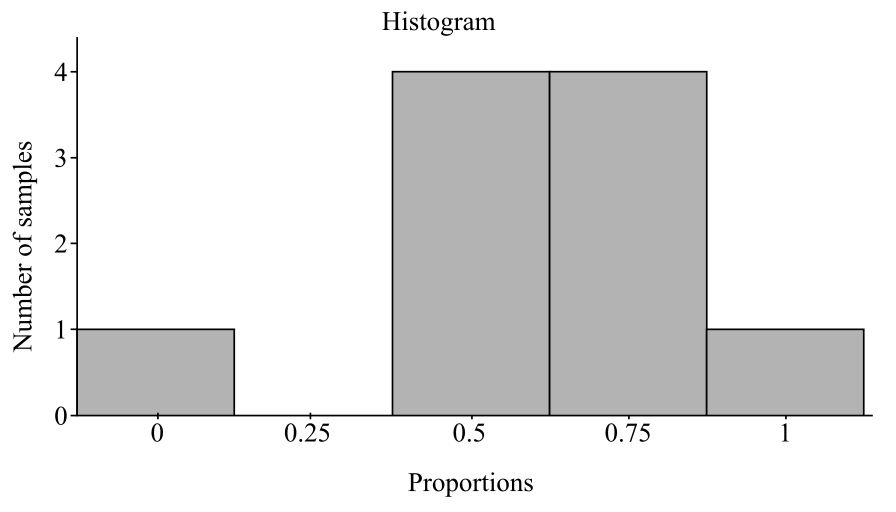
(a)
To find: The people who are selected for the simple random sample.
(a)
Answer to Problem 12E
Solution: The selected people are those who are labeled as 19, 22, 39, and 50.
Explanation of Solution
Calculation:
The people are labeled as
The people selected are the people who are numbered with the same number of the selected random numbers.
To find: The proportion,
Answer to Problem 12E
Solution: The required proportion is obtained as 0.5.
Explanation of Solution
Calculation:
According to the question, the colored circle indicates the persons who are opposing the constitutional amendment and the white circle represents the people who are in favor of the amendment. The selected persons are 19, 22, 39, and 50. Among them, 19 and 50 are the colored circles and 22 and 39 are the white circles.
Therefore, the proportion
(b)
To find: The people who are selected for the simple random sample.
(b)
Answer to Problem 12E
Solution: The selected people are those people who are labeled with the same number of selected random number and the samples are shown in the below table.
| Sample | Selected label |
| Sample 1 | 45, 46, 77, 17 |
| Sample 2 | 52, 71, 13, 88 |
| Sample 3 | 95, 59, 29, 40 |
| Sample 4 | 68, 41, 73, 50 |
| Sample 5 | 82, 73, 95, 78 |
| Sample 6 | 60, 94, 07, 20 |
| Sample 7 | 36, 00, 91, 93 |
| Sample 8 | 38, 44,84, 87 |
| Sample 9 | 73, 67, 64, 71 |
Explanation of Solution
Calculation:
The people are labeled as
The people selected are the people who are numbered with the same number of the selected random numbers.
Similarly, the other eight samples of size 4 are selected and the samples are shown in the below table.
| Sample | Selected label |
| Sample 1 | 45, 46, 77, 17 |
| Sample 2 | 52, 71, 13, 88 |
| Sample 3 | 95, 59, 29, 40 |
| Sample 4 | 68, 41, 73, 50 |
| Sample 5 | 82, 73, 95, 78 |
| Sample 6 | 60, 94, 07, 20 |
| Sample 7 | 36, 00, 91, 93 |
| Sample 8 | 38, 44, 84, 87 |
Here, the people selected in each set of sample are the people who are numbered with the same number of the selected random numbers.
To find: The proportion,
Answer to Problem 12E
Solution: The required proportions for the 10 samples are shown below.
| Sample | Labeled value | Proportion |
| Sample 1 | 45, 46, 77, 17 | 0.75 |
| Sample 2 | 52, 71, 13, 88 | 1 |
| Sample 3 | 95, 59, 29, 40 | 0.75 |
| Sample 4 | 68, 41, 73, 50 | 0.5 |
| Sample 5 | 82, 73, 95, 78 | 0.75 |
| Sample 6 | 60, 94, 07, 20 | 0 |
| Sample 7 | 36, 00, 91, 93 | 0.75 |
| Sample 8 | 38, 44,84, 87 | 0.5 |
| Sample 9 | 73, 67, 64, 71 | 0.5 |
| Sample 10 | 19, 22, 39, 50 | 0.5 |
Explanation of Solution
Calculation:
The calculation of the sample proportion,
| Sample | Labeled value | Colored circle | White circle | Proportion |
| Sample 1 | 45, 46, 77, 17 | 77 | 45, 46, 17 | |
| Sample 2 | 52, 71, 13, 88 | 88 | 52, 71, 13 | |
| Sample 3 | 95, 59, 29, 40 | 29, 40, 95, 59 | ||
| Sample 4 | 68, 41, 73, 50 | 73, 50 | 68, 41 | |
| Sample 5 | 82, 73, 95, 78 | 73, | 82, 95, 78 | |
| Sample 6 | 60, 94, 07, 20 | 60, 94, 07, 20 | ||
| Sample 7 | 36, 00, 91, 93 | 91 | 00, 36, 93 | |
| Sample 8 | 38, 44,84, 87 | 38, 87 | 44, 84 | |
| Sample 9 | 73, 67, 64, 71 | 73, 64 | 67, 71 | |
| Sample 10 | 19, 22, 39, 50 | 22, 39 | 19, 50 |
(c)
To graph: The histogram.
(c)
Answer to Problem 12E
Solution: The required histogram is shown below.

Explanation of Solution

Interpretation: From the hisogram it is clear that none of the sample has sample proportion of 0.25.
(d)
The number of sample proportion that estimates the population proportion as p = 0.5
(d)
Answer to Problem 12E
Solution: There are 4 samples that provide the proportion as 0.5.
Explanation of Solution
Whether the value 0.5 is in the center of the sample values.
Answer to Problem 12E
Solution: The original value 0.5 is in the center for the sample proportion values.
Explanation of Solution
To explain: The reason that the population proportion value will be in the center for the large samples.
Answer to Problem 12E
Solution: The value will be centered in 0.5 for large samples because the large samples have less variability than the small samples.
Explanation of Solution
Want to see more full solutions like this?
Chapter 3 Solutions
Statistics: Concepts and Controversies - WebAssign and eBook Access
- A company found that the daily sales revenue of its flagship product follows a normal distribution with a mean of $4500 and a standard deviation of $450. The company defines a "high-sales day" that is, any day with sales exceeding $4800. please provide a step by step on how to get the answers in excel Q: What percentage of days can the company expect to have "high-sales days" or sales greater than $4800? Q: What is the sales revenue threshold for the bottom 10% of days? (please note that 10% refers to the probability/area under bell curve towards the lower tail of bell curve) Provide answers in the yellow cellsarrow_forwardFind the critical value for a left-tailed test using the F distribution with a 0.025, degrees of freedom in the numerator=12, and degrees of freedom in the denominator = 50. A portion of the table of critical values of the F-distribution is provided. Click the icon to view the partial table of critical values of the F-distribution. What is the critical value? (Round to two decimal places as needed.)arrow_forwardA retail store manager claims that the average daily sales of the store are $1,500. You aim to test whether the actual average daily sales differ significantly from this claimed value. You can provide your answer by inserting a text box and the answer must include: Null hypothesis, Alternative hypothesis, Show answer (output table/summary table), and Conclusion based on the P value. Showing the calculation is a must. If calculation is missing,so please provide a step by step on the answers Numerical answers in the yellow cellsarrow_forward
 MATLAB: An Introduction with ApplicationsStatisticsISBN:9781119256830Author:Amos GilatPublisher:John Wiley & Sons Inc
MATLAB: An Introduction with ApplicationsStatisticsISBN:9781119256830Author:Amos GilatPublisher:John Wiley & Sons Inc Probability and Statistics for Engineering and th...StatisticsISBN:9781305251809Author:Jay L. DevorePublisher:Cengage Learning
Probability and Statistics for Engineering and th...StatisticsISBN:9781305251809Author:Jay L. DevorePublisher:Cengage Learning Statistics for The Behavioral Sciences (MindTap C...StatisticsISBN:9781305504912Author:Frederick J Gravetter, Larry B. WallnauPublisher:Cengage Learning
Statistics for The Behavioral Sciences (MindTap C...StatisticsISBN:9781305504912Author:Frederick J Gravetter, Larry B. WallnauPublisher:Cengage Learning Elementary Statistics: Picturing the World (7th E...StatisticsISBN:9780134683416Author:Ron Larson, Betsy FarberPublisher:PEARSON
Elementary Statistics: Picturing the World (7th E...StatisticsISBN:9780134683416Author:Ron Larson, Betsy FarberPublisher:PEARSON The Basic Practice of StatisticsStatisticsISBN:9781319042578Author:David S. Moore, William I. Notz, Michael A. FlignerPublisher:W. H. Freeman
The Basic Practice of StatisticsStatisticsISBN:9781319042578Author:David S. Moore, William I. Notz, Michael A. FlignerPublisher:W. H. Freeman Introduction to the Practice of StatisticsStatisticsISBN:9781319013387Author:David S. Moore, George P. McCabe, Bruce A. CraigPublisher:W. H. Freeman
Introduction to the Practice of StatisticsStatisticsISBN:9781319013387Author:David S. Moore, George P. McCabe, Bruce A. CraigPublisher:W. H. Freeman





